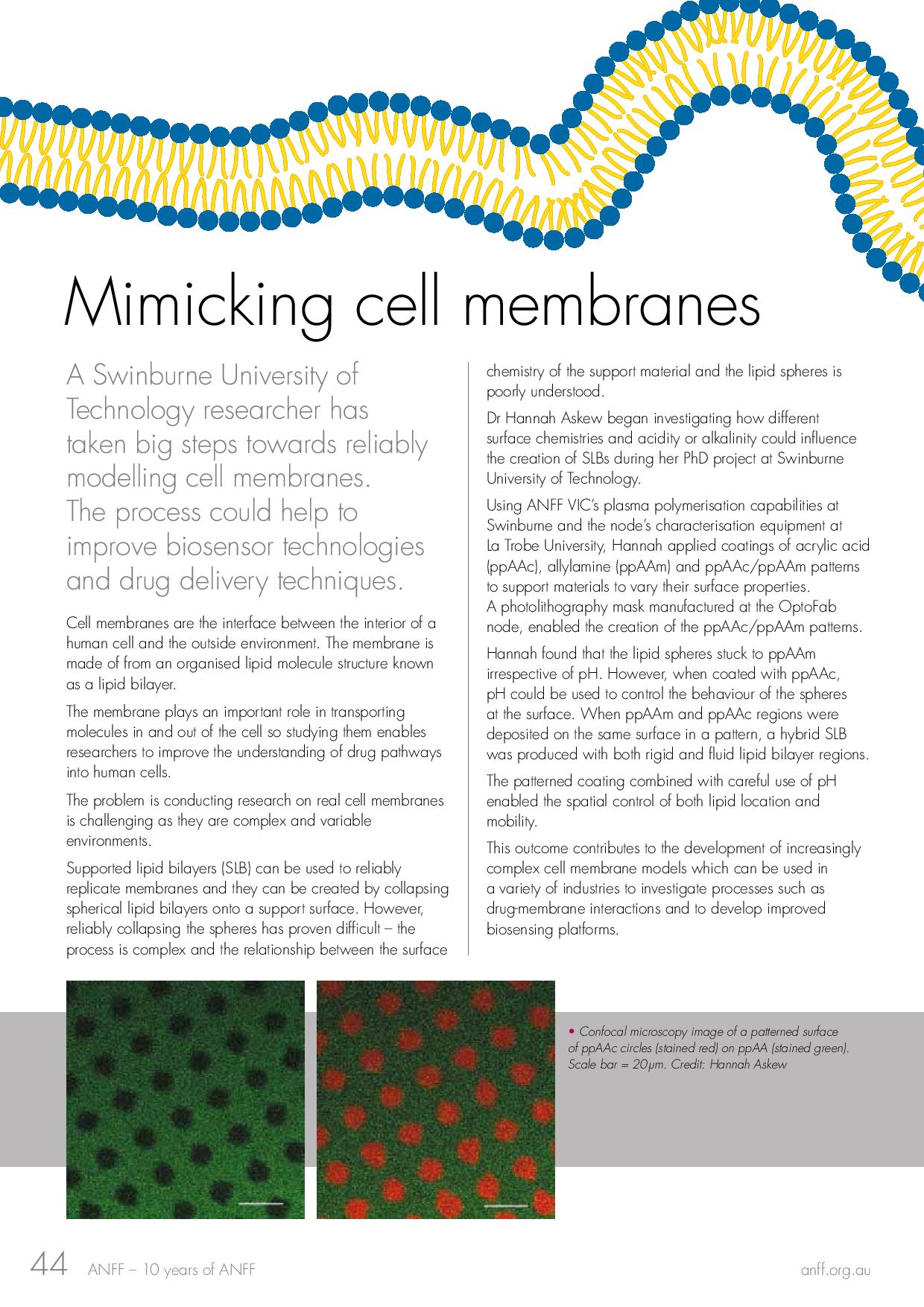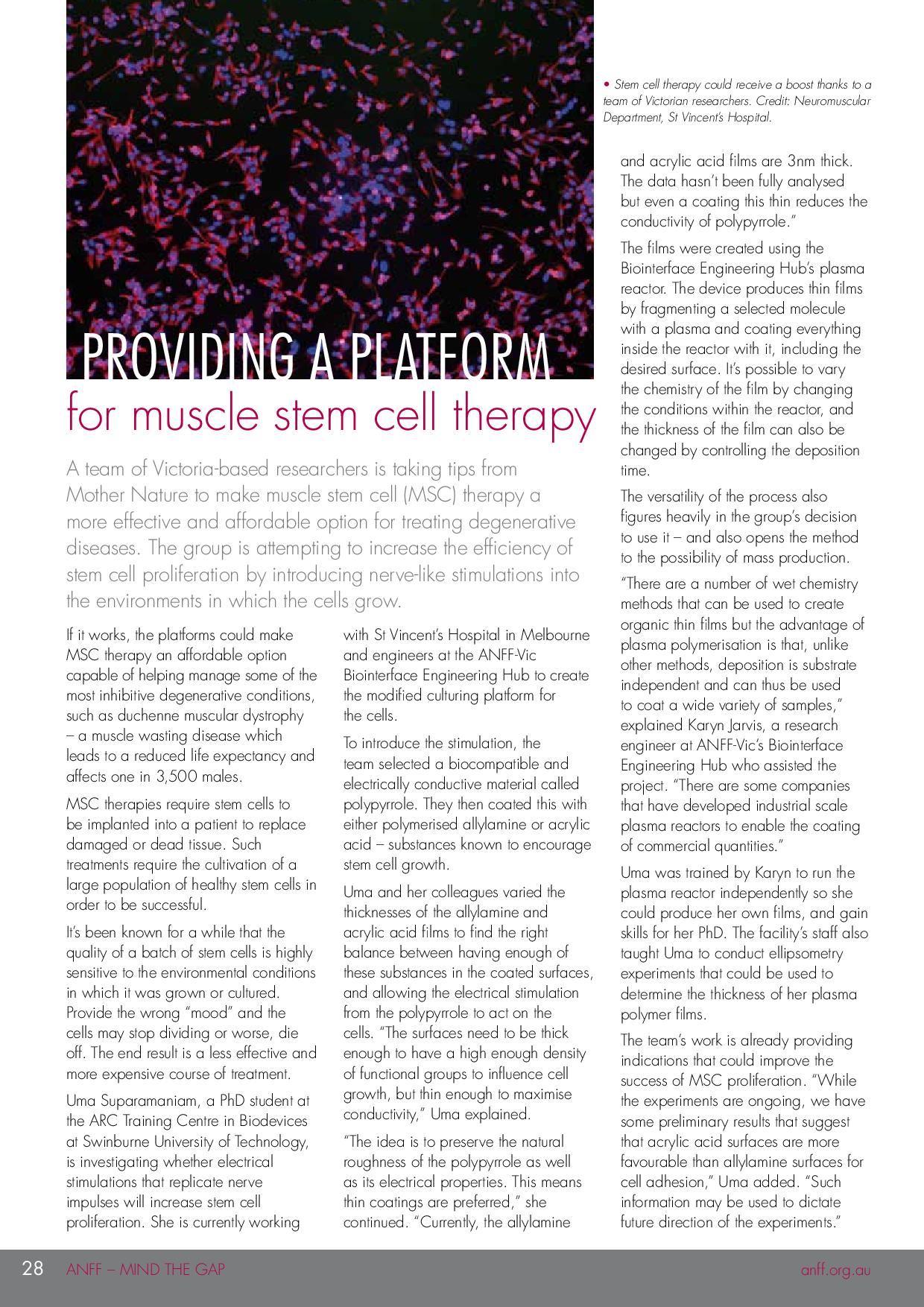
ANFF-VIC Biointerface Engineering Hub
The ANFF-Vic Biointerface Engineering Hub focuses on the use of synthetic and biological components to create materials and surfaces with new properties.
The ANFF-VIC Biointerface Hub has capabilities and expertise in the broad fields of thin film deposition and surface characterisation, which are utilised to produce materials and surfaces with specific properties.
Applications of our capabilities include, but are not limited to: biomaterials, biosensors, tissue engineering scaffolds, drug delivery, defence, manufacturing and space.
The facility has a wide range of capabilities in surface modification, surface characterisation, microgravity and laser machining.
Equipment
The hub houses specialised equipment, including:

Plasma Polymerisation Reactors
Deposits nanoscale coatings using plasma to vary the properties of a surface

Spectroscopic Ellipsometer
(J.A. Woollam M-200XI)
Non-destructive method for measuring film properties such as thickness

Multivessel Dipcoater
(KSV-NIMA)
Deposits coatings from solution by controlling dipping parameters

Quartz Crystal Microbalance with Dissipation (Q-Sense E4)
Detects mass changes at the sensor surface to monitor adsorption and desorption processes
Plasma polymerisation is a technique for modifying the surfaces of materials by adding a thin film which possesses specific functional groups. This technique can deposit films with a variety of chemistries, such as alkanes, alcohols, acids, amines, thiols, PEO-like and fluorocarbons. These functional films can vary the chemistry, charge and wettability of surfaces in addition to how they interact with various biological molecules such as proteins, cells and bacteria.
Plasma is produced by a glow discharge through gas or vapour at reduced pressure. The molecules of the gas or vapour are fragmented using radio frequency energy. The thickness, structure and surface functionalities of the film can be controlled by varying the plasma power, flow rate and deposition time.
Swinburne has six custom made plasma reactors, each designated for particular surface chemistries or applications. One of the reactors is heated, to enable the vaporisation of monomers with low volatility. Commonly deposited films include, but are not limited to, allylamine to produce positively charge amine terminated surface, acrylic acid to produce negatively charge carboxyl terminated surface and octadiene to produce carbon rich hydrophobic films.
Spectroscopic ellipsometry is a model based, non-destructive and non-contact optical characterisation technique used to determine a number of properties of a thin film, including thickness. Polarised light is shined on the surface, reflected and received by the detector. The changes in polarisation also enable several other parameters to be determined, including roughness, crystalline nature, doping concentration and electrical conductivity. Our ellipsometer has a wavelength range of 210 to 1690 nm and can measure film thicknesses between 2nm and 3nm.
Dip coating is a process to deposit thin films from solution. The substrate is immersed and withdrawn from coating material at a constant speed. A large variety of films can be produced by using either self-assembly, sol-gel chemistry or layer-by-layer assembly.
Different properties of the film can be controlled by varying parameters such as the submersion time, withdrawal speed and number of cycles.
Quartz Crystal Microbalance (QCM) detects mass changes at the sensor surface with nanoscale resolution. Molecule-surface interactions are detected as changes in mass, as the mass will increase as molecules adsorb and decrease as molecule desorb.
The QCM sensor oscillates at its resonance frequency by alternating voltage. The frequency of the sensor decreases when mass is attached to the sensor. QCM can be used to measure the interactions of proteins, polymers, surfactants and cells with surfaces in solution.
Plasma, a highly excited gas or vapour, usually needs lower than normal atmospheric pressure to occur. A small plasma jet can however be generated at standard atmospheric pressure using a stream of gas. In this atmospheric plasma system, a stream of air is used to clean and treat surfaces. The main advantage of atmospheric plasma is the speed of treatment in comparison to traditional low-pressure plasma, as the sample does not need to be placed in a low-pressure vessel and the air evacuated. Using atmospheric plasma, a surface can be treated in only a few minutes.
The air plasma jet is rastered across the sample, which typically removed any surface contamination and makes the surface more wettable (hydrophilic). This type of cleaning is often required prior to the deposition of a coating, as a clean surface results in better adhesion of the coating which often results in a longer lifetime. This atmospheric plasma instrument can also be used to deposit hexamethyldisiloxane (HMDSO) films. HMDSO films can be used to deposit a coating with variable properties, depending on the deposition parameters.
Wettability is a surface property that is important for a number of applications. For a hydrophilic surface, the water droplet spreads across the surface whereas for a hydrophobic surface a water droplet beads on the surface. Various surface modification techniques, such as plasma polymerisation, can be used to vary the wettability of a surface.
Contact angle uses a syringe to place a droplet of water onto the surface being investigated. An image taken of the droplet using a high-resolution camera is processed to determine the angle between the droplet and the surface. A highly wettable (hydrophilic) surface has a contact angle less than 90°. A less wettable (hydrophobic) surface has a contact angle greater than 90°. Contact angle is extremely useful for determining the effect of changing surface roughness and/or surface chemistry on the wettability of a surface.
Everything on Earth, including our experiments, are influence by gravity. Microgravity, refers to the weightless conditions an object experiments when the effect of gravity are cancelled out. Microgravity can be achieved at a lab-scale, using instruments such random positioning machines (RPMs). These instruments simulate microgravity using a program of randomly generated position that over long periods of time (days or weeks) negate the effect of gravity on the experiment. Microgravity experiments can be utilised to investigate how a number of processes, such as plant/cell/bacteria growth, electrolysis, manufacturing or microfluidics would function in low gravity environments, such as those in space.
Four microgravity reactors are available to accommodate a wide variety of samples. These reactors typically accommodate standard T25 cell culture flasks and multi-well plates. However other samples and/or sample holders can be accommodated on the 150 mm x 120 mm sample stage. These reactors also have electrical feedthroughs for experiments requiring power or real-time monitoring. Both zero G and variable G programs are available on all four reactors. Two dedicated incubators (Nuiare Direct Heat In-VitroCell) can each accommodate one reactor to enable microgravity experiments to be undertake at specific temperature and oxygen concentrations.
A femtosecond laser is a type of laser that operates with an ultrafast pulse duration in the femtosecond range (10⁻¹⁵ seconds). This enables extremely high peak powers, far exceeding those of continuous wave lasers. Femtosecond lasers are commonly used for multiphoton polymerisation, surface or volume modification, and ablation.
The FemtoLAB system is designed with a focus on precision rather than throughput, utilising precision stages and microscope objectives for tight focusing. It features a Carbide femtosecond laser with 40W power and a repetition rate of up to 2 MHz, offering first, second, and third harmonic generation with wavelengths of 1030 nm, 515 nm, and 343 nm, respectively. The Gaussian beam is tightly focused onto the sample by a microscope objective lens, with the sample secured on a precision X/Y stage with a travel range of 140 mm and vacuum hold. The system also includes a beam path for Bessel beam generation using an axicon lens. Additionally, a galvo scanner is incorporated, allowing for rapid laser beam positioning across a sample or surface without moving the sample itself.
PhD project proposals
We welcome expressions of interest in these projects. Please contact Dr Karyn Jarvis or Professor Paul Stoddart to discuss.
Supervisors: Paul Stoddart, Karyn Jarvis
The Australian National Fabrication Facility (ANFF) Biointerface Engineering Hub at Swinburne, specialises in plasma polymerisation. Plasma polymerisation is a versatile thin film deposition technique, which involves the attachment of specific chemistries on a surface via the plasma induced fragmentation of a particular gas or vapour. In this project, a specialised plasma polymer reactor will be used to monitor surface chemistry during the deposition process. In particular, real-time infrared spectroscopy and spectroscopic ellipsometry will be used to gain further insights into the plasma polymer deposition process for a variety of different film types.
Supervisors: Karyn Jarvis, Paul Stoddart
Plasma is considered the fourth state of matter. When it is combined with chemical vapour deposition, it enables unique chemical processes with important technological applications. A new atmospheric plasma system has been acquired as part of our ANFF facility, which will enable surfaces to be modified without the requirement of a vacuum system. Atmospheric plasma is a more industrially-relevant technique which can readily be integrated into existing manufacturing processes. In this project, the various parameters of the atmospheric plasma system will be investigated to gain an understanding of the range of chemistries, hydrophobicity and mechanical properties that can be produced.
Supervisors: Saulius Juodkazis, Karyn Jarvis, Paul Stoddart, Peter Kingshott
Micro- and nano-patterning of surface chemistry can be used to control the interfacial interactions of biological materials with advanced material surfaces and improve our understanding of how biology and man-made materials interact with each other. Previous work at our facility has shown that dual plasma polymer patterns can be deposited with feature sizes down to a width of 30 nm using electron beam lithography patterning, and with features 60 nm wide able to be visualised using advanced imaging techniques. In this project, a new femtosecond laser etching system and advanced imaging techniques will be investigated to determine the resolutions that can be produced in both single and dual plasma polymer patterns.
Our case studies

Mimicking cell membranes

Providing a platform for muscle stem cell therapy
Explore our news
Want to access our facility?
Our laboratory is available for access. Use the online booking system to access the facility or download the ANFF Victoria pricing and access document for more information about access and pricing.
Contact the ANFF-VIC Biointerface Engineering Hub
Whether you’re a PhD student, media or an organisation looking to collaborate and partner with us, please contact either:
Professor Paul Stoddart
Coordinator, ANFF-Vic Biointerface Engineering Hub
Dr Karyn Jarvis
Senior Research Engineer, ANFF -Vic Biointerface Engineering Hub
+61 3 9214 3898
kljarvis@swinburne.edu.au

